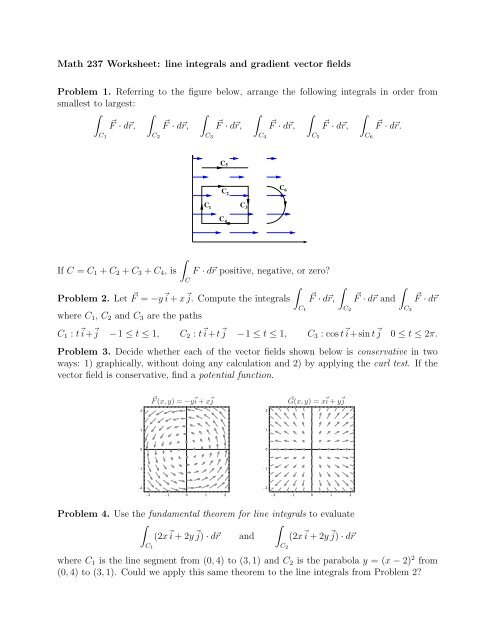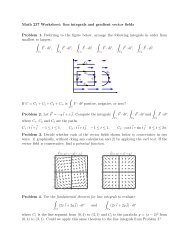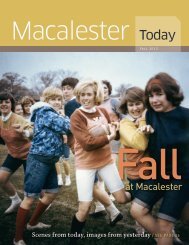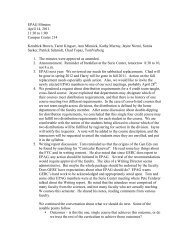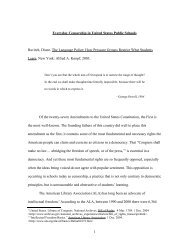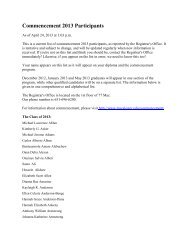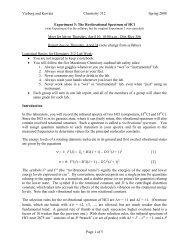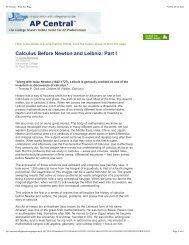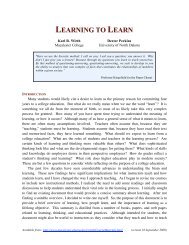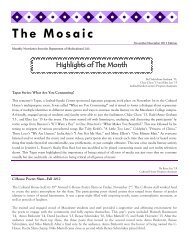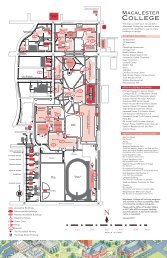Math 237 Worksheet: line integrals and gradient vector fields ...
Math 237 Worksheet: line integrals and gradient vector fields ...
Math 237 Worksheet: line integrals and gradient vector fields ...
Create successful ePaper yourself
Turn your PDF publications into a flip-book with our unique Google optimized e-Paper software.
<strong>Math</strong> <strong>237</strong> <strong>Worksheet</strong>: <strong>line</strong> <strong>integrals</strong> <strong>and</strong> <strong>gradient</strong> <strong>vector</strong> <strong>fields</strong><br />
Problem 1. Referring to the figure below, arrange the following <strong>integrals</strong> in order from<br />
smallest to largest:<br />
∫<br />
F ⃗ · d⃗r, F ⃗ · d⃗r, F ⃗ · d⃗r, F ⃗ · d⃗r, F ⃗ · d⃗r, F ⃗ · d⃗r.<br />
∫C 1<br />
∫C 2<br />
∫C 3<br />
∫C 4<br />
∫C 5<br />
Let F ⃗ (x, y) =y⃗i +2⃗j. Calculate ∫ ⃗ C<br />
F · d⃗r, where C is the portion of the parabola y = x 2 that starts at (0, 0)<br />
<strong>and</strong> ends at (3, 9).<br />
Examples <strong>and</strong> Exercises<br />
C 6<br />
1. Given to the right is a <strong>vector</strong> field ⃗ F (x, y), together with<br />
oriented curves C 1 ,C 2 ,C 3 ,C 4 ,C 5 , <strong>and</strong> C 6 .<br />
(a) Is ∫ ⃗F · d⃗r positive, negative, or zero? Explain.<br />
C6<br />
C<br />
5<br />
C<br />
2<br />
C<br />
6<br />
C<br />
1<br />
C<br />
3<br />
C<br />
4<br />
∫<br />
If C = C 1 + C 2 + C 3 + C 4 , is<br />
(b) Let C be the closed curve C 1 + C 2 + C 3 + C 4 . Is ∫ C ⃗ F · d⃗r positive, negative, or zero? Explain.<br />
C<br />
F · d⃗r positive, negative, or zero?<br />
∫<br />
Problem 2. Let F ⃗ = −y⃗i + x⃗j. Compute the <strong>integrals</strong> F ⃗ · d⃗r, F ⃗ · d⃗r <strong>and</strong><br />
∫C 1<br />
∫C 2<br />
where C 1 , C 2 <strong>and</strong> C 3 are the paths<br />
C 3<br />
⃗ F · d⃗r<br />
C 1 : t⃗i +⃗j − 1 ≤ t ≤ 1, C 2 : t⃗i + t⃗j − 1 ≤ t ≤ 1, C 3 : cos t⃗i + sin t⃗j 0 ≤ t ≤ 2π.<br />
Problem 3. Decide whether each of the <strong>vector</strong> <strong>fields</strong> shown below is conservative in two<br />
ways: 1) graphically, without doing any calculation <strong>and</strong> 2) by applying the curl test. If the<br />
<strong>vector</strong> field is conservative, find a potential function.<br />
Let ⃗ F <strong>and</strong> ⃗ G be the <strong>vector</strong> <strong>fields</strong><br />
whose formulas <strong>and</strong> graphs are<br />
shown to the right.<br />
2<br />
⃗F (x, y) =−y⃗i + x⃗j<br />
2<br />
⃗G(x, y) =x⃗i + y⃗j<br />
(a) Is ⃗ F conservative? Justify<br />
your answer graphically, without<br />
doing any calculations.<br />
1<br />
0<br />
1<br />
0<br />
1<br />
1<br />
(c) Arrange the following quantities in order from smallest to largest:<br />
2<br />
∫<br />
∫<br />
∫<br />
∫<br />
∫<br />
⃗F · d⃗r, ⃗F · d⃗r, ⃗F · d⃗r, ⃗F · d⃗r,<br />
2 1 0 1 2<br />
⃗F · d⃗r,<br />
∫<br />
2<br />
2 1 0 1 2<br />
⃗F · d⃗r<br />
C1<br />
C2<br />
C3<br />
4 Developed by Jerry Morris<br />
C4<br />
Problem 4. Use the fundamental theorem for <strong>line</strong> <strong>integrals</strong> to evaluate<br />
∫<br />
(2x⃗i + 2y⃗j) · d⃗r<br />
C 1<br />
<strong>and</strong><br />
∫<br />
(2x⃗i + 2y⃗j) · d⃗r<br />
C 2<br />
C5<br />
where C 1 is the <strong>line</strong> segment from (0, 4) to (3, 1) <strong>and</strong> C 2 is the parabola y = (x − 2) 2 from<br />
(0, 4) to (3, 1). Could we apply this same theorem to the <strong>line</strong> <strong>integrals</strong> from Problem 2?<br />
C6<br />
ities to accompany Calculus, Hughes-Hallett et al, Wiley, 2013 17
Problem 5. Consider the <strong>vector</strong> field ⃗ F =<br />
−y<br />
√<br />
x2 + y 2 ⃗i +<br />
conservative? What does the curl test say about this <strong>vector</strong> field?<br />
x<br />
√<br />
x2 + y 2 ⃗j. Is this <strong>vector</strong> field<br />
2


